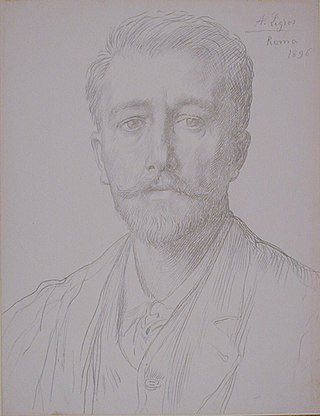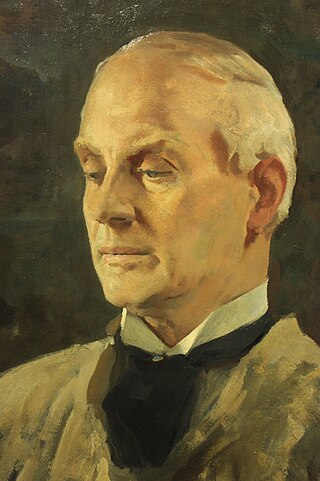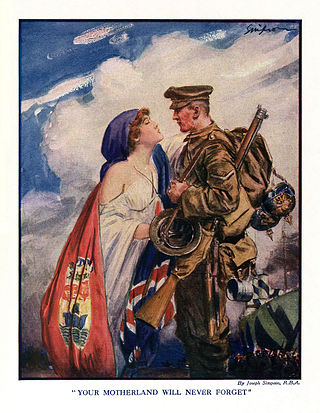Related Research Articles

Sir Francis Seymour Haden PPRE, was an English surgeon, better known as an original etcher who championed original printmaking. He was at the heart of the Etching Revival in Britain, and one of the founders of the Society of Painter-Etchers, now the Royal Society of Painter-Printmakers, as its first president. He was also a collector and scholar of Rembrandt's prints.

Sir Charles Holroyd RE was an English painter, original printmaker and curator during the late Victorian and Edwardian eras up to and including the First World War. He was Keeper of the Tate from 1897 to 1906, Director of the National Gallery from 1906 to 1916 and Assessor (Vice-President) of the Royal Society of Painter-Etchers & Engravers from 1902 to 1917.

Sir Francis Job Short PPRE was a British printmaker and teacher of printmaking. He revived the practices of mezzotint and pure aquatint, while expanding the expressive power of line in drypoint, etching and engraving. Short also wrote about printmaking to educate a wider public and was President of the Royal Society of Painter Etcher & Engavers from 1910 to 1938. He was a member of the Art Workers' Guild and was elected Master in 1901.

The etching revival was the re-emergence and invigoration of etching as an original form of printmaking during the period approximately from 1850 to 1930. The main centres were France, Britain and the United States, but other countries, such as the Netherlands, also participated. A strong collector's market developed, with the most sought-after artists achieving very high prices. This came to an abrupt end after the 1929 Wall Street crash wrecked what had become a very strong market among collectors, at a time when the typical style of the movement, still based on 19th-century developments, was becoming outdated.

Sir David Young Cameron was a Scottish painter and, with greater success, etcher, mostly of townscapes and landscapes in both cases. He was a leading figure in the final decades of the Etching Revival.

Edmund Blampied was one of the most eminent artists to come from the Channel Islands, yet he received no formal training in art until he was 15 years old. He was noted mostly for his etchings and drypoints published at the height of the print boom in the 1920s during the etching revival, but was also a lithographer, caricaturist, cartoonist, book illustrator and artist in oils, watercolours, silhouettes and bronze.
Frederick Landseer Maur Griggs was an English etcher, architectural draughtsman, illustrator, and early conservationist, associated with the late flowering of the Arts and Crafts movement in the Cotswolds, centered in Chipping Campden. He was one of the first etchers to be elected to full membership of the Royal Academy, and was part of the final phase of the Etching Revival in Britain. He was elected the Master of the Art Workers' Guild in 1934.

The Royal Society of Painter-Printmakers (RE), known until 1991 as the Royal Society of Painter-Etchers and Engravers, is a leading art institution based in London, England. The Royal Society of Painter-Etchers, as it was originally styled, was a society of etchers established in London in 1880 and given a Royal Charter in 1888. Engraving was included within the scope of the Society from 1897, wood-engraving from 1920, coloured original prints from 1957, lithography from 1987 and all forms of creative forward-thinking original printmaking from 1990.
Malcolm Charles Salaman was an English author, journalist and critic. He was born and died in London.
Robert Sargent Austin RA PPRWS PPRE was a noted artist, illustrator, engraver and currency designer and widely considered to be one of Britain's leading mid-twentieth century printmakers.

James McBey was a largely self-taught Scottish artist and etcher whose prints were highly valued during the later stages of the etching revival in the early 20th century. He was awarded an Honorary Doctor of Letters by Aberdeen University.

Joseph William Simpson (1879–1939) was a British painter and etcher of portraits and sporting subjects, and a magazine illustrator.
Malcolm OsbornePPRE was a British original printmaker known for his intaglio prints of landscapes, urban views and portraits.
Sydney Lee was a British wood engraver, active at the beginning of the twentieth century. He was a founder member of the Society of Wood Engravers (1920). He was also a painter in oils and a Royal Academician.
Leonard Beaumont (1891–1986) was an English printmaker, graphic designer, illustrator and publisher. He was one of the earliest exponents of the new art of linocut printmaking in Britain during the early 1930s. He was one of a small group of progressive and highly regarded printmakers who exhibited at the Redfern and Ward Galleries in central London. Whilst working in relative isolation in Yorkshire, most of his contemporaries were linked in some way to the Grosvenor School of Modern Art, located in Pimlico, London.
Fine Prints of the Year was an annual series of books that reported and discussed the etchings, engravings, woodcuts and lithographs published each year between 1923 and 1938 by major artists of the period. All volumes reproduced in monochrome on high quality glossy paper a selection of about 100 limited edition prints published during the preceding year. The series provides an important record of the work of artists in the last years of the etching revival and during the collapse of the market for prints.
Constance Mary Pott, RE, was an English printmaker and teacher active during the late nineteenth century and the twentieth century. She became technical and teaching assistant to the teacher and printmaker Sir Frank Short at the Royal College of Art from 1902 until Short's retirement in 1924. In her day she was recognized as a pioneer in the etching revival, for her dynamic, versatile mastery of technique and line, for the spacious evocation of landscape in her plates, and for her formal professional occupation, all exceptional achievements by any standards, but more especially so in their combining in her to overcome societal disapproval of professions for women. As a teacher she had a powerful and acknowledged influence upon a whole generation of engravers who passed through the College. However, she long outlived the fashion of that movement, and her central role in it was for a time almost forgotten. Examples of her own works, principally etchings, are held in leading national collections, and appear in the salerooms. She is sometimes confused with her mother, Constance Mary née Fearon, Mrs Henry Pott (1833-1915).
Edward Louis Lawrenson was an Irish painter of landscapes and an etcher.
Margaret Stirling Dobson ARE (1882-1965) was a Scottish painter, printmaker and author.

Ada Matilda Shrimpton was an English watercolour painter and printmaker.
References
- 1 2 The Times (1948). Obituary. Mr E.S. Lumsden. Etcher and Painter. The Times Saturday October 2, 1948, page 6.
- ↑ Boulet, Roger H. (2003). Ernest S. Lumsden 1883 - 1948. Visual Arts Burnaby: Canada.
- ↑ Hopkinson, Martin (1999). No day without a line. The History of the Royal Society of Painter-Printmakers, 1880–1999. Oxford: Ashmolean Museum
- ↑ Lumsden, E.S. (1925). The art of Etching. London: Seely, Service and Co. Ltd.